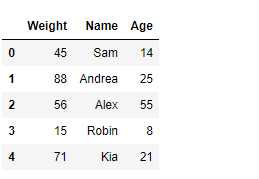Python | Pandas DataFrame.values
Pandas DataFrame - это двумерная потенциально неоднородная табличная структура данных с изменяемым размером и помеченными осями (строки и столбцы). Арифметические операции выравниваются по меткам строк и столбцов. Его можно рассматривать как dict-подобный контейнер для объектов Series. Это основная структура данных Pandas.
Pandas DataFrame.values attribute return a Numpy representation of the given DataFrame.
Syntax: DataFrame.values
Parameter : None
Returns : array
Example #1: Use DataFrame.values attribute to return the numpy representation of the given DataFrame.
# importing pandas as pdimport pandas as pd # Creating the DataFramedf = pd.DataFrame({"Weight":[45, 88, 56, 15, 71], "Name":["Sam", "Andrea", "Alex", "Robin", "Kia"], "Age":[14, 25, 55, 8, 21]}) # Print the DataFrameprint(df) |
Выход :
Now we will use DataFrame.values attribute to return the numpy representation of the given DataFrame.
# return the numpy representation of # this dataframeresult = df.values # Print the resultprint(result) |
Выход :

As we can see in the output, the DataFrame.values attribute has successfully returned the numpy representation of the given DataFrame.
Example #2: Use DataFrame.values attribute to return the numpy representation of the given DataFrame.
# importing pandas as pdimport pandas as pd # Creating the DataFramedf = pd.DataFrame({"A":[12, 4, 5, None, 1], "B":[7, 2, 54, 3, None], "C":[20, 16, 11, 3, 8], "D":[14, 3, None, 2, 6]}) # Print the DataFrameprint(df) |
Выход :
Now we will use DataFrame.values attribute to return the numpy representation of the given DataFrame.
# return the numpy representation of # this dataframeresult = df.values # Print the resultprint(result) |
Output :
As we can see in the output, the DataFrame.values attribute has successfully returned the numpy representation of the given DataFrame.
Внимание компьютерщик! Укрепите свои основы с помощью базового курса программирования Python и изучите основы.
Для начала подготовьтесь к собеседованию. Расширьте свои концепции структур данных с помощью курса Python DS. А чтобы начать свое путешествие по машинному обучению, присоединяйтесь к курсу Машинное обучение - базовый уровень.